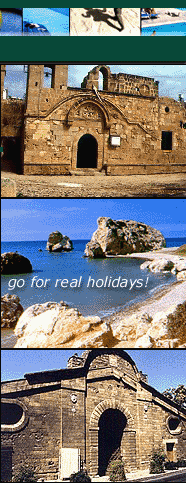 »
CYPRUS
LOCATION |

|
|
||||||||||||||
|
The capital of Cyprus, in the middle of the island, is cut in two by the Green Line which divides the country. Since the wall came down in Berlin, it's the only divided capital in the world. A visit here might help you understand the problems Cyprus is facing, and should also give you a less touristy view of the country than you'll get if you stick to the coastal towns. The old town, inside the 16th century Venetian walls, is the most interesting part of Nicosia, with the city centre and municipal gardens just outside the wall on the south-west side. Nicosia: The Leventis Municipal Museum traces the development of the city from prehistoric times and gives a pretty good overview - it's not a bad place to start your Lefkosian experience. Half a km to the east you'll find a museum of culture, Dragoman Hadjigeorgakis. The exhibits are nothing special, but the building - a 15th to 18th century mansion - is gorgeous. For some really spectacular museum pieces try the Byzantine Museum in the downright ugly Archbishop's Palace, which has a superb collection of religious icons and mosaics. In the grounds of the museum, St John's Cathedral has some recently restored 18th century frescoes. Once the main entrance to the city, the Famagusta Gate, on the eastern wall, is beautifully preserved and is now used as a cultural centre. |
||||||||||||||||
| ........... | ||||||||||||||||
